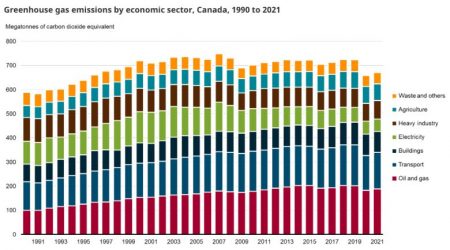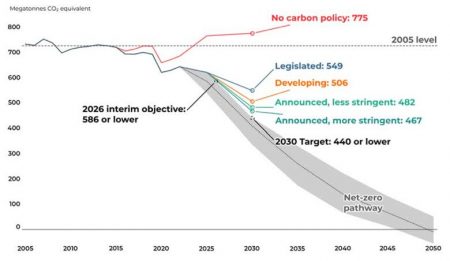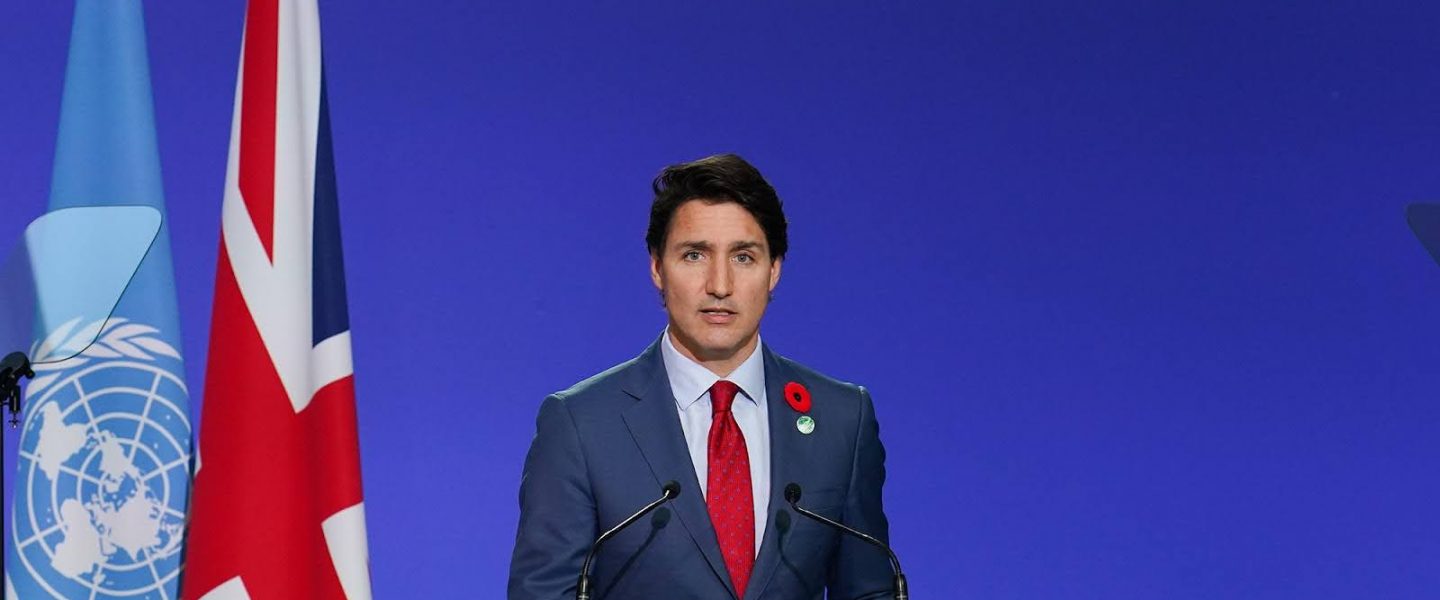How Oil Sands Undermine Canada’s Climate Goals
Canada is considered a leader in climate policy. But its emissions remain stubbornly high.
|
Listen To This Story
|
This story by Dana Nuccitelli was originally published by Yale Climate Connections and is part of Covering Climate Now, a global journalism collaboration strengthening coverage of the climate story.
•
Now in his ninth year as prime minister, Justin Trudeau has sought to position Canada as a global climate leader, touting one of the world’s highest taxes on carbon pollution, clean fuel regulations, and clean technology tax credits. Yet Canada’s per-person climate pollution remains stubbornly near the top of the list of developed countries — alongside the United States and Australia, whose governments have been less consistently supportive of climate solutions over the past decade.
Climate Action Tracker, an independent project that monitors whether governments’ actions measure up to the goals outlined in the Paris climate agreement, rates Canada’s climate policies as “highly insufficient.” The project noted, “If all countries were to follow Canada’s approach, warming could reach over 3°C and up to 4°C” — a potentially catastrophic level of global warming. The Trudeau government has pledged to cut emissions by at least 40-45 percent below 2005 levels by 2030 but is not on track to meet that goal.
This raises the question: What’s holding back Canada’s climate ambitions? Although there are numerous contributing factors, Climate Action Tracker points to one primary culprit, arguing that “Canada seems incapable of kicking its oil and gas addiction.” Canada is the fourth-largest producer of oil and the fifth-largest producer of methane gas, commonly called natural gas, in the world. Nearly 80 percent of Canadian oil is exported to the United States, and fossil fuels account for over one-fifth of the country’s exports, worth over $100 billion per year.
So the country exemplifies the challenge of solving the climate crisis even when relatively climate-aware governments are in power.
Why Canada’s Climate Progress Is Stuck in the Oil Sands
The oil and gas industry is the largest source of Canadian climate pollution, at 28 percent of the country’s total emissions. That’s up from a 17 percent share in 1990 and 23 percent in 2005.

Photo credit: Government of Canada
An increasing proportion of Canadian fossil fuels have come from the oil sands in the western province of Alberta. Oil sands are an unconventional source of oil composed of a mix of sand, clay, water, and bitumen, which is a dense form of petroleum similar to asphalt. Because of the thickness of bitumen, it’s difficult to extract and thus requires more energy and emissions of climate-warming gases than drilling for conventional oil. Across their life cycle, emissions from oil sands are about 30 percent higher than from conventional oil sources.
According to an analysis by the Pembina Institute energy think tank, the oil sands accounted for about one-quarter of all Canadian oil production in 2000, but their share has spiked to almost two-thirds today. Total oil sands production has quintupled over that time frame, adding nearly $55 billion more to Canada’s economy today than in 2000.
As a result, Canada extracts about three times more oil per person than the United States, generating about five times more oil-industry-related climate pollution per Canadian than the average American — despite the fact that the US has recently been setting numerous oil production records.
To address this source of emissions, the Canadian government plans to cap and reduce the amount of climate pollution that its oil and gas industry is allowed to generate. The Pembina Institute said in a report that oil sands extractors plan to achieve these emissions reductions by deploying technologies like small nuclear reactors and carbon capture and storage, but “many of these emerging technologies are yet to be commercialized.”
Nevertheless, Janetta McKenzie, acting director of the Pembina Institute’s Oil and Gas program, says that the industry could achieve the needed emissions cuts.
“Oil sands producers can reduce methane for relatively low costs, plus invest in other solutions, like carbon capture and improvements in solvent use to reduce the amount of steam needed,” McKenzie wrote in an email. “Electrification of upstream processes is also a solution to reduce emissions in the sector.”
How Carbon Pricing Works in Canada
Canada’s broadest climate policy is its Greenhouse Gas Pollution Pricing Act. Passed in 2018, the law imposed a price on carbon pollution that increases over time. While this policy financially penalizes emissions from most sectors of the economy, the biggest sources of Canadian climate pollution come from industries where a carbon price tends not to work very effectively.
Oil and gas are globally traded commodities, and nearly 100 countries produce fossil fuels. As a result, declines in Canadian oil production could simply be replaced by increased drilling in other countries. For this reason, the Trudeau government structured its carbon pricing system to refund about 80 percent of climate pollution fees paid by “emissions-intensive and trade-exposed” industries like oil and gas, so that they don’t face a disadvantage on the global market. The carbon price does incentivize oil companies to generate lower emissions than their competitors in Canada, and the amount of carbon generated by producing a barrel of Canadian oil has declined in recent years due to improved efficiency. But the existence of the industry rebate and global fossil fuel market blunt the carbon price’s effectiveness at spurring oil and gas emissions cuts.
Transportation is Canada’s second-largest source of carbon pollution, accounting for 22 percent of the nation’s emissions. The carbon price adds about US$0.50 to the cost of a gallon of gasoline today. But since the COVID-19 pandemic emerged and snarled supply chains, Canadian gasoline prices have varied wildly between about $2.20 and $6.00 per gallon (USD). This instability in gas prices has much more of an effect on drivers’ behavior than the carbon tax.
Carbon pricing is most effective at reducing power sector emissions, where solar and wind energy provide a clean and affordable alternative to fossil fuels. But Canada already generated 60 percent of its power from hydroelectricity in 2005. With the replacement of coal with cheaper and cleaner power sources having cut that sector’s emissions in half over the past 15 years, electricity is now responsible for less than 8 percent of Canadian carbon pollution.
The carbon price has also been implemented during a time of rapidly rising inflation and costs of living. The policy was designed to blunt financial impacts on Canadians, returning about 90 percent of the revenue back to households. Today, about 80 percent of Canadians get more money back in rebates than they pay in increased costs due to the carbon price. Only those with the biggest carbon footprints — who in most cases are the wealthiest Canadians — experience a net cost from the policy.
But the carbon price rebates are opaque, usually coming in the form of quarterly direct bank deposits that don’t specify their source. According to a recent survey, 37 percent of Canadians don’t think or aren’t sure if they have received a carbon tax rebate, and only 14 percent think the refund exceeds their carbon costs. What’s more, the Trudeau government recently exempted home heating oil from the carbon tax, raising doubts about the policy and ultimately making it harder to reduce the 13 percent of Canadian carbon emissions that come from the building sector. And so the popularity of Canada’s carbon price policy has declined from 56 percent in 2021 to 45 percent in 2023. The conservative political opposition has launched an “ax the tax” campaign, copying the slogan from the Australian effort that successfully repealed that country’s short-lived carbon price a decade ago. (To date the Conservatives hold a large lead over Trudeau’s Liberal party in recent polling, although the next Canadian federal election isn’t scheduled until October 2025.)
For now, the Canadian government has estimated that the national carbon price, which will rise from C$65 per ton of carbon dioxide today to C$170 per ton in 2030, will achieve about 30 percent of the emissions cuts needed to meet its Paris commitment by that date.
Still, the question remains …
Can Canada Meet Its Climate Goals?
The Trudeau administration has passed and proposed a variety of additional climate policies to help reach net-zero emissions by 2050. These include the aforementioned cap on oil and gas sector emissions, proposed regulations on vehicle emissions, a requirement that all new cars sold in 2035 be zero-emissions like electric cars and plug-in hybrids, and clean electricity regulations for new power generation needed to meet growing demand as other sectors like transportation and buildings go electric.
In its 2023 emissions reductions plan progress report, the Canadian government estimated that the country would cut its climate pollution to 36 percent below 2005 levels by 2030 if all of its proposed climate policies are fully implemented, missing its pledge to cut emissions 40-45 percent over that time frame. An independent assessment by the Canadian Climate Institute similarly concluded that implementing the government’s full suite of proposed climate policies would reduce emissions 34-36 percent by 2030, while the already-enacted legislation would result in a 25 percent cut by 2030. The Trudeau government’s climate policies are making a difference — the report estimates that without them, Canadian climate pollution would have increased 6 percent by 2030.

Photo credit: Canadian Climate Institute PDF
Ultimately, although the Trudeau government has expressed ambitions to curb climate change and is passing a suite of climate policies, the global thirst for fossil fuel and the country’s domestic resources pose substantial roadblocks to those goals. But with energy experts at the International Energy Agency and McKinsey predicting that global oil demand will peak by the end of this decade, the world’s slaking thirst for oil may begin to solve Canada’s emissions challenge.
Until then, despite the government’s ambitions, Canadians’ per-person climate pollution may remain stubbornly higher than most of their wealthy nation peers.


